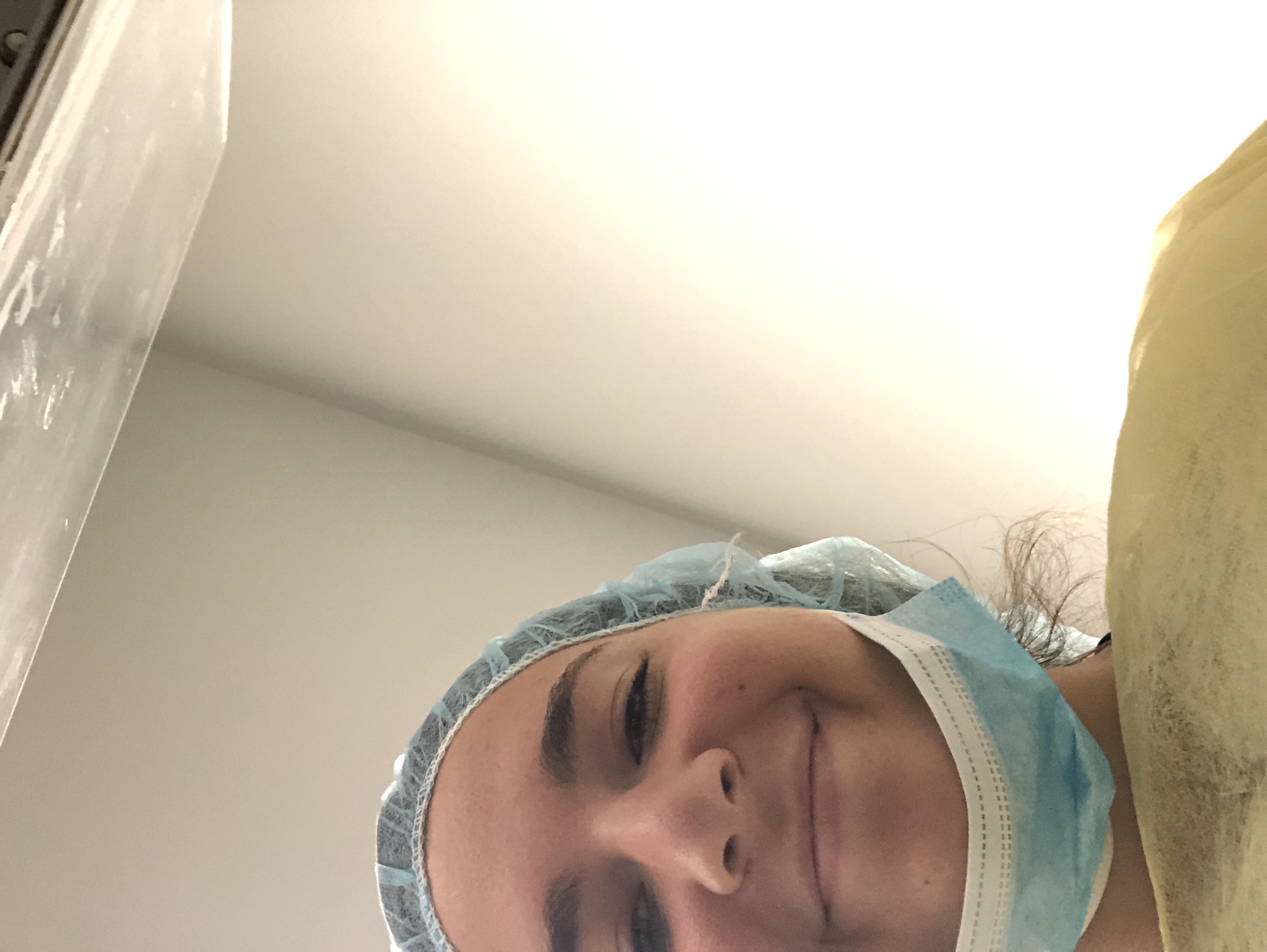Above: Researchers from the Kellendonk Lab. Michelle Dandeneau ’20 is pictured in the back row, third from the right, in a gray turtleneck sweater.
As an undergraduate research assistant in the Kellendonk Lab at Columbia, Michelle Dandeneau ’20 said she had the opportunity to “soak up as much knowledge as possible.” Dandeneau worked with mentor Kelly Martyniuk, a Ph.D. student in neuroscience and behavior at Columbia, to examine the brain’s receptors for dopamine (a hormone that affects emotions, movement, and the brain’s reward system) and the impact they have throughout a learning task. During her time in the lab, Dandeneau assisted with carrying out and collecting data on behavioral experiments.
For Dandeneau, being a research assistant — as well as a neuroscience and behavior major at Barnard — helped her to gain a multitude of STEM skills and the confidence to continue working in the field even after facing challenges. She credits her peers and her professors for teaching her valuable lessons in neuroscience and research that have allowed her to move forward in her career. Dandeneau now works at Phreesia, a software company aimed at streamlining the patient intake process.
To learn more about the research Dandeneau conducted at Barnard, recently published in the journal Behavioral Neuroscience, read the Q&A below.
How would you describe the research from your recent journal article to a lay audience?
This research, in very simple terms, investigates the role of dopamine receptors in a pivotal learning pathway in our brain during associative reward learning tasks. More specifically, this study looks at how increasing dopamine D2 receptors on a type of projection neuron (iSPNs) in the ventral striatum — more specifically the nucleus accumbens — affects associative reward learning. Whereas previous studies showed that increasing the number of D2R receptors on these neurons can contribute to an increase in motivation, our results show that increasing the amount of these D2 receptors, which have an inhibitory role in dopamine pathways, do not affect an animal’s ability to successfully perform associative and reward-based learning tasks.
What was your role?
In the lab, I mainly performed tasks such as immunohistochemistry, microscopy, and carrying out and collecting data on the behavioral tasks the mice were performing. I then studied the specific antibodies. I worked side by side with my mentor, Kelly Martyniuk, to help understand what the data we were collecting meant, as well as to determine what needed to be accomplished next. More than anything, my biggest role in the lab was as a student trying to soak up as much knowledge as possible. I was given the opportunity to learn from an amazing mentor, her incredible peers in the Kellendonk Lab, and from the research itself.
Why is it important to study this topic?
Associative reward learning is the basis by which humans learn and grow in our environment. Understanding the neurological mechanisms behind associative learning helps us better understand the ways in which humans navigate our world, as well as what can impair the learning that is so essential to our everyday lives. The neurological pathways that control this type of learning are also at the core of illnesses like substance abuse. Uncovering the impact of even a small change to any one of these neurological mechanisms contributes to a greater understanding of human behavior, especially those behaviors that can negatively impact one’s life.
The confidence I have now in being able to face the unknown and adapt can absolutely be attributed to having done it my entire time at Barnard.
Who has influenced your thinking most in this area?
The people who influenced my thinking the most in neuroscience are not those I read about in scientific papers but those with whom I interacted daily throughout college.
At Barnard, my professors were incredibly important in influencing the way I thought about neuroscience and research. My thesis advisor, John Glendinning, constantly pushed me to think outside the box about the topic I was studying. He asked questions about my research that made me think critically, while also encouraging me to appreciate the journey that is conducting research as an undergrad.
Within the lab, my mentor Kelly not only was able to informally teach me highly specific and complicated neuroscience but also was able to teach me how to tackle seemingly impossible-to-answer questions through the tools available to us. So much of the way I now think about science is because I was able to listen and learn from Kelly, as well as those I met at the Kellendonk Lab. The research being done there is driven by individuals whose interests span diverse disciplines, allowing them to look at scientific problems through more than one lens and be creative in their approach. Coming from Barnard, where students often don’t fit into a singular intellectual mold, the Kellendonk Lab was a perfect fit for me.
Finally, my peers from my senior thesis seminar were a great influence on the way I thought about neuroscience. My friend and classmate Emily Sherman ’20, who is now getting her Ph.D. in neuroscience at Cambridge, once told me that research isn’t as complicated as it seems. Once you simplify the question you’re trying to answer, you can simplify your experiment to match and still obtain amazing results. That always stuck with me.
Where do you see this research going in the future?
This study was able to rule out one neurological mechanism that could potentially contribute to impaired associative and reward learning. This means that there are still a lot of unknowns in the dopaminergic pathways that contribute to learning. Further research I helped conduct looked at the impact of dopamine D2 receptors on neurons from another striatal structure in the brain, asking similar questions while using a slightly different approach. Other research can continue to dive into understanding how these receptors can modulate functions of reward-learning pathways, while also looking at other neurotransmitter interactions. As long as there are questions to be asked, the research possibilities are practically endless.
How has this experience been useful to you since graduating?
While I am not currently conducting research, the skills that I gained while doing research at Barnard have been immensely impactful in my day-to-day life. Conducting scientific research forces you to think both creatively and critically about a problem, understand what questions have already been answered, and determine what still needs to be solved. I can apply that skill to any problem I encounter now. I currently work in health technology, which is constantly evolving, and where flexibility is a necessity. The confidence I have now in being able to face the unknown and adapt can absolutely be attributed to having done it my entire time at Barnard, and even more so while writing my senior thesis.
—MAYA GILBERT ’22




